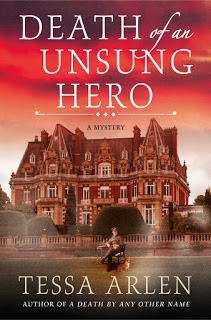 Tessa Arlen is the author of the Lady Montfort and Mrs. Jackson historical mystery series set in England in the early nineteen-hundreds. Her latest mystery, Death of an Unsung Hero, takes place in 1916 in WW1 in a hospital for shell-shocked officers.
Tessa Arlen is the author of the Lady Montfort and Mrs. Jackson historical mystery series set in England in the early nineteen-hundreds. Her latest mystery, Death of an Unsung Hero, takes place in 1916 in WW1 in a hospital for shell-shocked officers.Arlen’s top five historical novels:
I, Claudius, by Robert Graves is a superbly chronicled account of Rome’s ambitious, corrupt and ruthless Julio-Claudian dynasty. Richly detailed, often very funny, it relates the adventures of the Emperor Claudius who was considered to be an idiot by his powerful family. By playing up to theirVisit Tessa Arlen's website.expectations Claudius survived Emperor Augustus' ruthlessly ambitious wife, Livia, who had a tendency to meddle with poison, to become the only emperor who struggled to return Rome to the republic.
Kate Atkinson's A God in Ruins. I am never disappointed by this author, and her two books about the Todd family (spanning the first five decades of the 20th century) are extraordinarily atmospheric in time and place. A God in Ruins (Book #2) tells the story through Teddy Todd: would-be poet, heroic WW2 fighter pilot, husband, father, and grandfather, as he navigates the perils and progress of a rapidly changing world that brought out some ofthe very best and worst of human kind.
Patrick O'Brian’s honest to goodness and utterly lovable Captain Jack Aubrey and his more complex friend and fellow shipment (surgeon/spy/naturalist) Stephen Maturin are the mainstays of this twenty-one book series set during the Napoleonic wars in the British Royal Navy. In The Nutmeg of Consolation, the name of a sweet-smelling ship from the spice islands, Aubrey and Maturin are temporarily out of action on an island in the South China Sea where Aubrey and his starving crew are attacked by pirates then rescued by a Chinese ship that takes them to Batavia, where Raffles (SirStamford who bought the island of Singapore in 1822) has a ship, the Nutmeg, for them. O’Brian used the massive naval archive of documents and ships logs at the British Maritime Museum for his research, but it is his richly depicted characters that make these books such pleasurable reading.
Umberto Eco’s The Name of the Rose takes place in a bleakly cold and isolated Benedictine monastery in 1327 during the darkest days of Christian government when the Catholic church considered heresy to be an unpardonable sin and had perfected the atrocities of the Inquisition to root out dissenters.This is not the sort of book you want to read on a cold, wet winter afternoon when your bank account is at an all-time low, or your adolescent children are giving you hell, but it does have some wonderful moments, not least a plot with as many twists and turns as an ancient medieval library.
The first historical novel I read was Katherine by Anya Seton. I was thirteen and teeming with hormones, so this deeply romantic love story was everything I needed to while away the tedious hours of a girls boarding school in rural England. Written in 1954 it tells the story of the historically important, 14th-century love affair in England between KatherineSwynford and John of Gaunt, Duke of Lancaster, the third surviving son of King Edward III. I was in love with John of Gaunt for years, but more importantly, this well-researched novel is a fascinating mediaeval history of the last of the Plantagenet rulers. If you have an adolescent daughter who spends too much time texting, then give her this to read!
Coffee with a Canine: Tessa Arlen & Daphne.
--Marshal Zeringue



